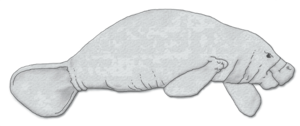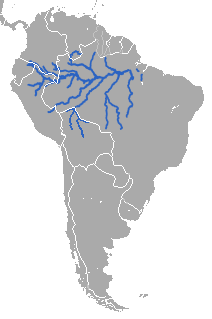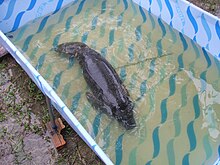Amazon manatee
| Amazon manatee | ||||||||||||
|---|---|---|---|---|---|---|---|---|---|---|---|---|

Amazon manatee ( Trichechus inunguis ) |
||||||||||||
| Systematics | ||||||||||||
|
||||||||||||
| Scientific name | ||||||||||||
| Trichechus inunguis | ||||||||||||
| ( Natterer , 1883) |
The Amazon or river manatee ( Trichechus inunguis ) is a Seekuhart from the family of manatees (Trichechidae). It is the smallest of the three species in this family and the only one that lives exclusively in freshwater.
description
Amazonian manatees differ from the other manatees in their more delicate, slimmer build and their striking white or pink markings on the chest and belly. Adult animals are no longer than 2.8 meters and weigh a maximum of 480 kilograms. In their physique they are similar to the other manatees: the trunk is round and stocky, the fluke (tail fin) is round and the hind limbs are missing. The front limbs are transformed into fins, but these are longer than in the two other manatee species and the nails are missing. The skull is narrow and elongated compared to the other species. As with all manatees, the eyes are small, as are the ear openings, there is no external auricle. The thick skin is colored gray and provided with colorless, bristle-like hair.
distribution and habitat
Amazon manatees are native to much of the Amazon basin in northern South America. They can be found in some of the Amazon tributaries in Ecuador , Peru , Bolivia , Venezuela and Colombia as well as in the Amazon itself and several tributaries including the Purús , the Rio Negro , the Madeira , the Xingú and the Tocantins . There are also reports of Amazon manatees from Essequibo in Guyana , but the sightings in the Orinoco are unlikely to be accurate.
They prefer black water , backwaters or lagoons as habitat , they stay in waters with 22 to 30 ° C.
Way of life
Amazon manatees often live in small family groups of four to eight animals. They are both diurnal and nocturnal and, like all manatees, spend their entire life in the water. They typically emerge several times a minute to breathe, but can remain underwater for up to 14 minutes. They undertake hikes that are related to the seasonal food supply. In the dry season they go to deeper lakes and rivers, which can lead to real masses; every year around 1000 manatees gather in Lago Amana in western Brazil to spend the dry season there.
food
The diet of these animals consists of aquatic plants such as vallisneria , horn leaf , water lettuce , arrowhead and others. Especially in the rainy season, they eat large quantities of plants every day and build up supplies so that they can go without food for a long time in the dry season.
Reproduction
Especially between February and May, when the water levels rise in the Amazon basin, the cows throw a single young animal after a gestation period of around one year. Newborns weigh 10 to 15 kilograms, the calves stay with their mother for up to two years. The exact lifespan is not known; These manatees did not live more than twelve years in captivity, but the potential life expectancy is likely to be much higher.
threat
Amazonian manatees have been hunted by white settlers since the 17th century. It is estimated that between 1000 and 2000 manatees were killed in Amazonia each year between 1780 and 1925. After that, the demand for the hide leather was made from increased and the number of kills rose to 10,000 per year. In the 1960s, these numbers dropped rapidly as there were not enough manatees left. The river manatee has been fully protected in Brazil since 1973. The IUCN classifies it as endangered. It is also threatened by the destruction of the rainforests , poaching , asphyxiation in fishing nets and illegal discharge of mercury into rivers.
literature
- Ronald M. Nowak: Walker's Mammals of the World . Johns Hopkins University Press, 1999 ISBN 0801857899
- Sandra L. Husar: Trichechus inunguis , in: Mammalian Species 72, The American Society of Mammalogists 1977 ( PDF )
Web links
- Trichechus inunguis in the endangered Red List species the IUCN 2006. Posted by: Sirenia Specialist Group, 1996. Retrieved on 11 May, 2006.

